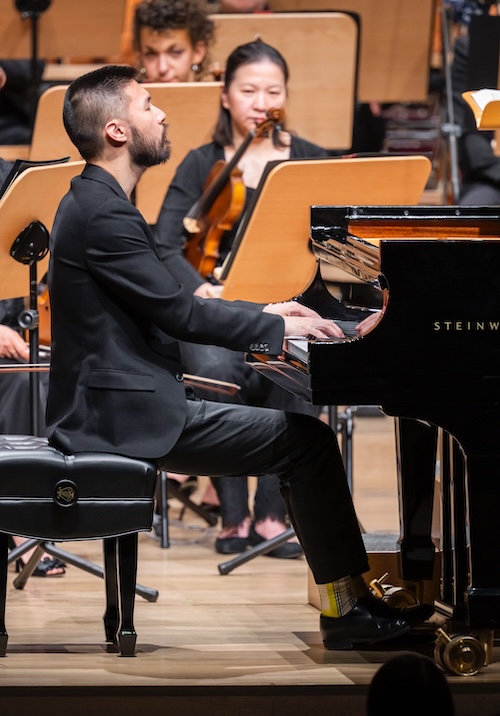Tao’s fresh, illuminating Mozart highlights a standard Philharmonic program

On paper, this week’s New York Philharmonic program is as standard as it gets: Mendelssohn’s Hebrides Overture; Mozart’s Piano Concerto No. 17; and Beethoven’s Fifth Symphony.
That leaves little room for surprise, nor anything to expect outside of great music well played. But Wednesday night’s opening concert did deliver the unexpected in two ways, the generally underwhelming interpretations from the orchestra under music director Jaap van Zweden, and the wild-card that is pianist Conrad Tao.
While the overture/concerto/symphony sequence is not inherently a bad idea, such a predictable selection makes it hard for an orchestra to show its character. This is a general challenge for the Philharmonic and van Zweded. With the pandemic interruption and upcoming early departure, he and the orchestra have never developed an identifiable sound or direction. Which was the main problem Wednesday.
Mendelssohn’s overture was smooth and easy to listen to, but without any character. The strings had a glowing sheen, but no atmosphere, and the playing wandered in a nether region between pictorialism and drama. The main expressive element in the music is changes in dynamics, and those came with abrupt jumps that never made enough space for a narrative to grow. Though technically solid, one felt the orchestra needed more time to understand why they were playing the music.
Tao was the antidote to this. He’s one of many pianists with the chops to play anything and the ideas to make it compelling. The past few years he’s been exploring improvisation and returning its traditional presence to the classical repertoire. He has improvised in cadenzas from Gershwin and Mozart, and Wednesday night he played his own cadenzas in the latter’s G Major concerto.
His playing in the main solo parts was brilliant, with a spryness to his fingering that made the piano part sparkle. To each repetition of a phrase, he added idiomatic ornamentations, even improvisational phrases in carefully chosen spaces in the Andante. It goes without saying that this was bursting with purpose and personality and was Mozartian in the extreme. Tao’s playing also contrasted with the orchestra, which played ably but never had the singing quality that Mozart demands.
Tao’s first cadenza, which reinvented the opening piano material via variations and modulations and, with Tao’s sympathy for Mozart, sounded like what the piano music would be if Le Nozze di Figaro had been a silent film. The second movement cadenza was brilliant, sounding like Tao had uncovered a previously lost Mozart sonata. The finale was the most satisfying of all, with his musical comments throughout the variations of the rondo form sounding like the ideal realization of the soloist-with-orchestra concept.
This was a rare experience of fresh rediscovery in the classical concert hall and one that every music lover should seek out as it’s both historically meaningful and dazzling fun. Tao’s approach means that each upcoming performance promises to be different from the others, all superb. As should be his encores: Wednesday it was a gorgeous and joyful performance of his own transcription of Art Tatum’s virtuosic recording of “Over the Rainbow.”
After intermission, the performance of Beethoven’s Symphony No. 5 was a sort of sandwich, the chewy bread of the first and last movements wrapped around a center that needed a better blend of ingredients and spices. Van Zweden is always at his best when the music moves quickly, and Beethoven certainly obliges in the opening and closing movements. Taking the briefest pause on the fermatas of the opening fanfare, conductor and orchestra promised to build the tension wound into the core of the symphony, and in the first movement they delivered with strength and focus.
But the middle movements were wan and at times tiresome. There was plenty of energy—the Andante was on the quick side—but as in the Mendelssohn there was no consistent direction. Van Zweden one moment focused on a sense of pride and dignity, on another a questing, driving feeling, never quite establishing either. In the third movement, his fussy attention to almost every note in the strings presented a literal confusion of the trees for the forest.
The transition to the finale did build tension, though it was sadly interrupted by someone’s phone loudly ringing, and the last movement itself was truly spectacular, exploding with spirit. It brought down the house, but couldn’t make this into a fully successful performance.
The program will be repeated 7:30 p.m. Thursday, 8 p.m. Saturday and 7:30 p.m. Tuesday. nyphil.org